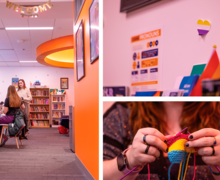Limited financial aid available for international students
Financial aid for international students is limited, especially this year with their enrollment at its highest level ever at Syracuse University.
There are 2,763 international students at SU, but there is ‘very, very little’ financial aid available for them, said Patricia Burak, director of the Lillian and Emanuel Slutzker Center for International Students. International students are not allowed to apply for FAFSA and usually only find financial support from SU through merit-based aid, which has been cut back in recent years, she said.
Tuition for international students amounts to $55,326, which is $3,366 more than undergraduate domestic student tuition. Last year, the number of international students was 2,690 and the year before it was at 2,388, Burak said. They currently make up 8 percent of the student body, Burak said.
International students have been increasing in numbers at SU in the past five years, said Don Saleh, vice president for enrollment management. Ten years ago, international students made up about 2 percent of the student population, and the percent has more than tripled since then, he said.
But there is a limited amount of money available for international students based on merit or need, Saleh said. Money is distributed to students who truly need it, Saleh said, but exact numbers were unavailable.
Sarah Cho is a citizen of South Korea and attended an American high school in India. When the sophomore electrical engineering student was thinking about college, she said she knew she would be going to college in America.
Cho decided on SU knowing financial aid was limited, but she was convinced by the quality of its engineering program, she said.
‘I knew they weren’t giving financial aid,’ Cho said. ‘I knew that it was an expensive school, but it was the one I chose.’
Cho attends SU without any financial aid. She said the school should offer more aid to international students through merit scholarships, determined by criteria like being placed on the Dean’s List. She does not have Federal Work-Study and cannot get a job off campus, as her student visa does not allow for outside employment.
The increase in international students was due to more applications coming in from abroad, because the university has increased foreign recruiting over the past decade.
Other colleges and universities have used recruiting abroad to attract students who typically pay the full ticket price. But SU is not targeting international students because they pay more tuition, as other schools have, Saleh said.
‘The driving force here is to build a student body that is rich in diversity,’ Saleh said.
During the admissions process, the same or possibly higher expectations for classroom performance are placed on international students over domestic students.
They are required to submit the same application as domestic students, and transcripts, SAT or ACT scores and essays are all considered. A group of SU admissions counselors who are familiar with the cultural education in other countries examines international students’ applications and takes their cultural backgrounds into consideration, Saleh said.
When looking at SAT scores, he said, the admissions group will usually see strong math scores and lower reading or writing scores with international students.
International students who may not be proficient in English are also required to take an English test to prove their ability and must register for a student visa, which will prove they have the financial resources to pay the university, Saleh said. Once accepted, some students may be required to take an English as a second language course.
Isabel Dong, a sophomore advertising major and Cho’s roommate, chose to come to SU because of the S.I. Newhouse School of Public Communication’s reputation abroad. Dong, who was born in the United States but has lived in South Korea since she was eight, applied to 11 American schools.
Dong, whose first language is Korean, was required to take the Test of English as a Foreign Language (TOEFL) and the SAT, on which she received an 1880. She was also accepted to the University of Massachusetts, University of Connecticut and University of Iowa, among others.
Funding her college choice has been difficult for her and her friends, she said. Work-Study is the best choice, but she said it is often not offered. She called the difference between domestic student financial opportunities and international student financial opportunities ‘unfair.’
The opportunity to have international students on campus is similar to going abroad, Burak, the director of the international center, said. She said it was a unique opportunity for American students to have a diverse campus.
‘It is a very positive and enriching experience for U.S. nationals who have not traveled abroad,’ she said.
This year, the most students came from China and Korea, and Burak said she expects to see the overall number of international students continue to increase.
There is a draw for students to apply to study in the United States because it is known as a place that welcomes religions and cultures, Burak said. And SU is no exception to this, she said, as the campus has a mosque, the Alibrandi Catholic Center and Winnick Hillel Center for Jewish Life.
‘The United States is the place where people from the rest of the world want to come,’ Burak said. ‘It has been this way for generations.’
Published on October 26, 2010 at 12:00 pm
Contact Dara: dkmcbrid@syr.edu | @daramcbride





